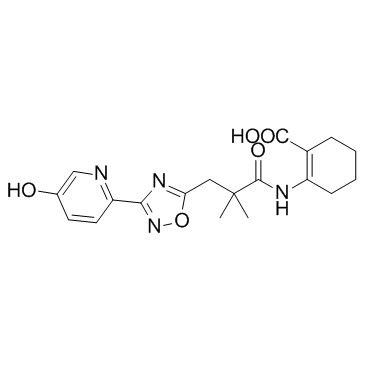917910-45-3
| Name | 2-({3-[3-(5-Hydroxy-2-pyridinyl)-1,2,4-oxadiazol-5-yl]-2,2-dimeth ylpropanoyl}amino)-1-cyclohexene-1-carboxylic acid |
|---|---|
| Synonyms | MK-6892 |
| Description | MK-6892 is a potent, selective, and full agonist for the high affinity nicotinic acid (NA) receptor GPR109A. Ki and GTPγS EC50 of MK-6892 on the Human GPR109A is 4 nM and 16 nM, respectively. |
|---|---|
| Related Catalog | |
| Target |
Ki: 4 nM (GPR109A)[1] EC50: 16 nM (GPR109A)[1] |
| In Vitro | MK-6892 evokes a potent internalization of GPR109A in U2OS β-arrestin2-RrGFP cells.MK-6892 shows an EC50 value of 74 nM on calcium mobilization assay[2]. |
| In Vivo | MK-6892 is orally administered to WT or nicotinic acid (NA) receptor null mice on the same C57Bl/6 genetic background. After 15 min of 100 mg/kg dosing of MK-6892 to fed WT or NA receptor null mice, the blood levels of MK-6892 at 15 min are 229 μM (~950-fold greater than the in vitro EC50 determined in mouse NA receptor GTPγS assay, which is 240 nM) in WT mice and 148 μM (~620-fold greater than the in vitro EC50) in NA receptor null mice. MK-6892 effectively suppresses plasma FFA in the WT but not in the NA receptor null animals, indicating that the FFA reduction of MK-6892 is NA receptor-dependent. MK-6892 is selected for the studies because of its good PK and activity profiles in these two species (EC50=4.6 μM in the GTPγS assay for the rat NA receptor and 1.3 μM in the GTPγS assay for the dog NA receptor). Despite the significant weaker activity of MK-6892 in rat and dog with respect to that in human, MK-6892 shows good activity in reducing FFA in rat and dog models[1]. |
| References |
| Molecular Formula | C19H22N4O5 |
|---|---|
| Molecular Weight | 386.40200 |
| Exact Mass | 386.15900 |
| PSA | 141.93000 |
| LogP | 3.27510 |
